While Kiwi fruit is not native to the UK, kiwi plants can be grown with ease in this climate. The compact bushes provide delicious, sweet furry brown fruit, with delicate bright green flesh.
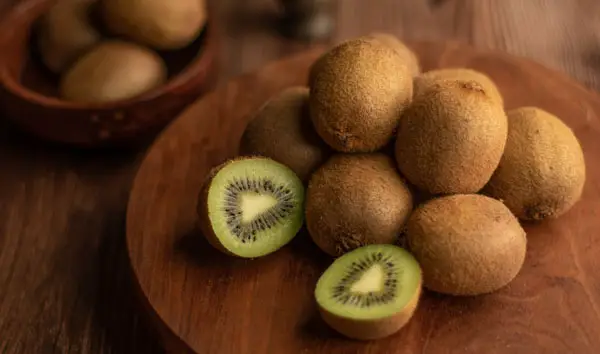
When picked fresh from the bush, kiwi fruit taste fantastic, and have a much higher nutrient content than those that are transported across the world to reach our supermarkets.
If you grow your own kiwi fruit, you’ll be lowering your carbon footprint, as there will be les (or no) food miles involved in you eating your delicious kiwis.
Kiwi fruit bushes are vigorous plants that can grow up to 9m tall. It needs plenty of sunlight and shelter in order to thrive. The fruits grow on vines, and its large leaves are heart-shaped.
Jump To...
About Kiwi Plants
Kiwi fruit, aka Chinese Gooseberries, were first found growing in the wilds of China and then became popular in New Zealand.
It didn’t actually acquire the name kiwi until 1959 and since then it’s gained in popularity among keen gardeners here in the UK. It is high in vitamin C and vitamin K and has many other health benefits. Health factors aside, they are also great in smoothies, jams, desserts, cakes, and salads.
Although they are largely deemed as exotic fruit, they can do very well grown in the average UK garden. They make wonderful ornamental plants but also provide you with a heavy crop in the plant’s third year.
Kiwi plants climb so they need robust support and you will be rewarded with pretty white and yellow flowers in the early summer.
They have a gorgeous smell about them too, attracting plenty of bees. This delicious fruit can be enjoyed in the Autumn time.
Growing Kiwi Plants – Fruit Care Guide
Kiwi fruit bushes need to be carefully trained and pruned to provide you with the greatest numbers of fruit.
They grow best on a south or west-facing wall, but in mild areas they can be grown in the open on a sturdy support such as a pergola.
Plant them 3-5m apart in fertile, well-drained soil that’s packed full of rich, organic matter.
Maintain the plants’ health by regularly watering them and giving them an annual mulch of well-rotted animal manure or compost. A liquid feed may also be necessary each week during the growing season.
When To Plant Kiwi Fruit
Kiwi plants are prone to frost damage so, therefore, should be planted once the risk of frost has passed.
Anywhere between March and May is fine, if there is a late frost you may need to add some horticultural fleece.
Where To Plant Kiwis
Kiwi plants need shelter and sun – these two key elements will provide it with the best possible conditions.
They need fertile, well-drained soil and something they can climb up – a trellis, fence, or wall. The vines need this support and without it will not do well. They do well planted on mounds of earth much like potatoes.
How To Plant Kiwis
Kiwi plants like moisture but they mustn’t be sitting in water all the time as this will spoil them.
You need to decide where to put the suitable support for your kiwi vine and then position the plant near to here so it’s angled towards it.
As the plant grows you can attach the shoots to the support and water it often as it establishes itself.
Pruning Your Kiwi Plant
Pruning is important to ensure your kiwi vine is at the healthiest it can be and any diseased shoots are removed.
If you get a huge supply of fruit you can thin this out so you get a more manageable crop size. You can cut shoots back to encourage new growth the next year and thinning out also ensures enough light enters the plant. Winter pruning will be essential for mature plants.
Kiwi fruit are best trained as espaliers on horizontal wires. Tie in the main vertical shoot to the support, then prune away vertical shoots and tie in horizontal shoots to supports.
Pinch out the growing tips when they have filled the space given to them. Allow side-shoots to develop every 50cm, and pinch them back to just five leaves.
These should fruit the following year. In winter prune the fruiting lateral branches back to two or three buds beyond where the last fruit grew.
Kiwi Plant Supports & Trellises
- Arch or Pergola: these provide great support for your kiwi plant and are very decorative too. The main shoot just needs to be tied to the support and you can enjoy the flowers and then the fruit.
- Espalier training: this is perfect if you have a south or south-west facing wall in your garden. You just need to decide how many tiers you’d like and position the wires and in time, the bamboo canes.
- Post and wire: this is a good alternative if you don’t have an arch or a sunny facing wall available. Once erected, you can train the vines to climb up each post.
- Border supports: these are usually made from steel and provide good support to your border.
- Climbing plant pole: for a more unusual feature why not opt for a wooden plant pole? These just need some wire adding and then you have everything to train your vines to climb the pole.
When To Harvest Kiwi Fruit
It’s important to pick your kiwi fruit at the right time because it doesn’t ordinarily ripen once picked in the UK.
The longer you leave it on the plants the better and it’s fine to do this well into Autumn. You can soften them on a sunny windowsill or conservatory if they are a little firm.
Pests and diseases rarely attack kiwi fruits, but you should harvest the fruits as they ripen. They will store well in the fridge for up to six weeks.
Growing Kiwis in Pots
Kiwis can be grown in pots like many other fruits which may suit smaller spaces and balconies better.
You just need to make sure you have support for the plants to climb up and that the pot is placed south facing in a sunny location.
Flowers and Pollination
Male and female flowers grow on separate plants, so you will need a plant of both sexes in order to produce a crop of Kiwi fruit.
If you are planning to grow a mini kiwi orchard, you’ll only need one male plant for every eight females. That said, there are plenty of self fertile varieties available if you are short on space to grow your fruit garden.
The bushes will start to fruit when they are five years old. They fruit on the previous year’s wood and can produce up to 100kg of fruit per plant.
Varieties of Kiwi Fruit
- Hayward (female) – the most widely grown variety. It is the least vigorous and latest-flowering cultivar. Its fruits are large, with a good flavour
- Bruno (female) – this produces plenty of large, elongated fruits
- Tomuri (male) – this plant flowers late, so makes a perfect partner for Hayward
Whether you have a large garden, or a small back yard, if you have a south-facing wall a kiwi fruit can make an attractive and interesting addition to your plot. They are loaded with vitamin C, and taste delicious, making them a serious consideration for the kitchen gardener.
Common Kiwi Pests & Problems
Although there aren’t a huge amount of pests and diseases that kiwi plants are susceptible to, there are a few things you’ll need to be aware of.
Paying attention to these issues will ensure the best possible fruit harvest.
- Wind and cold damage: kiwi plants can be vulnerable to harsh weather conditions which is why they need a sheltered location in your garden. During cold snaps, you can use horticultural fleece.
- Leaf rolling caterpillars: the damage they cause is quite minimal so often you won’t need to take action. They nest in the plant which can be seen by leaves being rolled and tired with silk.
- Phytophthora Root Rot: sadly this disease can go unnoticed until it is too late. In the end, the plant will wilt despite getting an adequate water supply. You need to replant in another area if this occurs.
Kiwi Plant FAQ’s
Still not sure if kiwi plants are the right choice for your garden? Our guide to the most commonly asked questions about the fruit will help you decide!
There are a few self-fertile kiwi plants on today’s market including; Solo, Soloissimo, and Jenny kiwis. These are a good solution if you are short of space otherwise you should plant male and female plants. Vines should be planted close together for best results.
You will be treated to the sight and smell of the yellow and white flowers in the early summer months.
Growing from seed won’t produce you with the normal fruit you’d get by planting a shop-bought kiwi plant. However, you will get a nice ornamental variety that may or may not be edible. Scoop the kiwi seeds out of the flesh by slicing the kiwi in half. Rinse the seeds and then pop in a plastic bag with a damp piece of kitchen roll. Pop them on a sunny windowsill and look for signs of germination in the weeks that follow. The paper towel should be moist at all times. You can pot your seeds once they’ve germinated and keep them indoors until the weather is suitable for planting outdoors.
Kiwis grow on vines, not trees, however, these vines can climb up into trees giving the mistaken appearance of a kiwi tree.

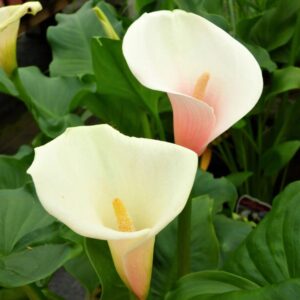

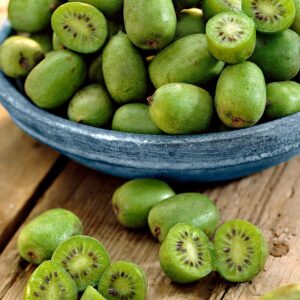
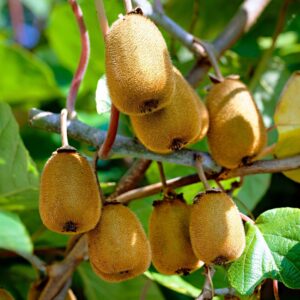
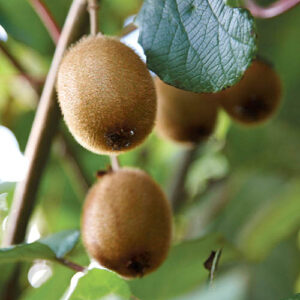

I have only one plant which is now about 7 years old and it is full of fruit. Does that mean that my plant is of both male & female? It spreads about 7 feet high and 12 feet wide but the fruit is never really that big. Is there anything that I can do to get bigger fruit on it?
My kiwi always produces masses of fruit but they never grow any larger than a peanut. What is going wrong.
@Smithy – Kiwi fruit require a long growing season (at least 240 frost-free days) and as specified in the article while they will tolerate some shade, they much prefer a sunny location and shelter from the wind. They are heavy nitrogen feeders also. However, given that you have grown them successfully in previous years, I can only assume an unnaturally cool temprature has impeded fruit growth.
I have well established kiwi plants in the garden,(male and female) they bear fruit each year. There must be well over 70 kiwis at the moment but they are all about golf ball size and never get any bigger, it was the same last year. Any ideas as to what I maybe doing wrong, thanks in advance.
I have an established kiwi plant, approx 5 metres long, trained horizontally along a fence one metre high, sheltered from the wind by a parallel fence. But no fruit ever shows, in 6 or 7 years. Is this plant seeking sexual partners? How to tell what to buy & plant?
we have a large and established kiwi in our garden , although it flowers it does not bear fruit, i have been looking for both a male and female plant to be sure that it pollinates but with no luck in local garden centres in Staffordshire ,only self fertile plants seem to be available. can you help ? many thanks
I have planted one Kiwi plant 3 years ago, now I realize I must have a male and female version, how do I know the sex of my plant?
I’ve ive got a kiwi bush called Janine I take it this must be female, so I’ll need a male plant to produce fruit What’s the best male for the job?
At what time of the year are kiwi fruits ripe for eating?
I have had kiwi fruit for a few years now, the first time it fruited we had bucket loads, but in the last three years although it flowers hundreds of fruit, they drop off with the petals. I do prune it in january. Thank you
I have a kiwi fruit vine in my greenhouse for over seven years and cut it back every year, the next year it grows beautifully and looks lush but we have never had any fruit or blossom. I did buy another two plants as I was told I should have a male and female, I have had these for some 3 years but still no fruit and no blossom, possible they are all the same sex. What am I doing wrong and how can I tell if I have only one species. thank you
Where can I get M / Female Kwik Plants, I am in Hertfordshire so I may be able to and get them
I’m now trying kiwi plant called jenny that does not need to be male or female, it is self fertile. It’s only a small baby but should end up covering over 4metres and may take up to 3 to 4 years before I get fruit can’t wait.
I have 2 Kiwi plants, every year it flowers and there are about 400 to 500 young fruits, but before it could get bigger , the autumn starts and they don’t get big enough to pick, they drop off from the tree mid autumn. How can I get it to ripe before the autumn? Any suggestions.
The flowers will be the giveaway. Male flowers produce pollen only, and will have no stigma or ovum. Without actually knowing what they look like, I cannot say any more, though in most cases, the vestigial fruit is visible behind (at the base) of a female flower. To give an example this is quite clear with marrows etc, which are either male or female flowers, or tomatoes which are both male and female. Somewhere, there must be pictures of the male and female flowers.
We planted a kiwi plant in our garden against a fence, and it has grown very well, the only snag is that in the 9 years that is there hasn’t produced any fruit. We realize that it may be a male, the label is no longer there so that we can’t identify what it is. How can we find out. Is that anything to do with the size of the leaves? They are right now very large. It started being a small cane, but now has taken over part of the fence, and no fruit. Can you help us?
We have a great looking kiwi which my husband has grown from a seed. He loves it. My question is how can I tell if we have a female or male, perhaps I should buy a male and a female plant them near to it in the polly tunnel and wait and see, whats your advice?